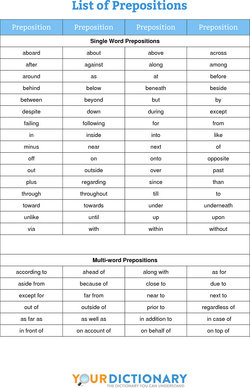Prepositional Phrases Easy Definition of a Parallel Structure
Prepositional Phrases and How They Function
Prepositional phrases modify nouns and verbs while indicating various relationships between subjects and verbs. They are used to color and inform sentences in powerful ways. Keep reading to learn more about prepositional phrases and how they function in a sentence.
 prepositional phrase example
prepositional phrase example
Parts of a Prepositional Phrase
Prepositional phrases consist of two parts: a preposition and an object of that preposition. These parts are typically right next to each other in a sentence. While both a preposition and an object can function as different parts of a sentence, they are the only parts of a prepositional phrase.
The Preposition
Prepositions are indeclinable words, or words that have only one possible form, that establish the relationship between words in a sentence. For example, after is a preposition, but afters or aftering are not possible forms of after.
Additional common prepositions include:
- about
- across
- around
- before
- by
- like
- near
- of
- out
- through
- to
The preposition in a prepositional phrase links the word prior to it with another noun. Prepositions are helpful to establish location or other relationships. The following chart lists the most commonly used prepositions in English.

View & Download PDF
The Object of the Preposition
The noun phrase or pronoun that follows the preposition is called the object of the preposition. For example, "behind the couch" is a prepositional phrase where behind is the preposition and the noun phrase the couch acts as the object of the preposition. Sometimes adjectives modify the object of the preposition, as in "behind the big old smelly green couch."
Examples of the object of a preposition include:
- about my homework
- across the river
- around the corner
- before March
- by myself
- like your brother
- near the grocery store
- of milk and honey
- out the door
- through thick and thin
- to Grandma's house
The prepositions establish relationships between these objects and other words. For example, in the sentence "I had a question about my homework," the preposition "about" connects the words "question" and "homework." The whole prepositional phrase modifies "question."
Formal Functions of Prepositions
Prepositions perform three formal functions in sentences. They can act as an adjective modifying a noun, as an adverb modifying a verb, or as a nominal when used in conjunction with the verb form to be. Prepositional phrase examples that show the different functions can help you understand them better.
Prepositions Functioning as Adjectives
In the following sentences, prepositional phrases perform the function of modifying the nouns boat, pen and truck:
- Look at the boat with the blue sail.
- Please hand me the pen next to the telephone.
- Have him move the truck with the trailer.
Prepositions Functioning as Adverbs
Adverbs modify verbs by explaining when, where, how, and to what extent something is occurring. In these examples, notice how the prepositional phrases perform adverbial functions by modifying the verbs runs, stalled and won.
- The coyote runs after the rabbit.
- The car stalled despite the tune-up.
- The team won without the starting quarterback.
Prepositions Functioning as Nominals
In English, sometimes words function as nouns but aren't themselves nouns. These words are called nominals. Prepositional phrases sometimes perform this important function in sentences when they are used in conjunction with the verb to be.
For example:
- The park is next to the hospital.
- The student is between an A and a B.
- The fight scene is before the second act.
Semantic Properties of Prepositions
In semantic terms, the function of prepositional phrases is to illustrate a particular relationship between words. These relationships include spatial, logical or temporal relationships between the object of the prepositional phrase and the other components of the sentence.
Spatial Relationships
Spatial relationships tell where something is located relative to another noun.
Consider the following examples:
- The dog is asleep on his bed.
- The dog is asleep under the bed.
- The dog is asleep next to the bed.
Changing the preposition in each prepositional phrase creates an entirely different sentence. Spatial relationships work with prepositions that show location such as on, under, next to, behind, above, out, and between.
Temporal Relationships
Prepositional phrases can establish time relationships, known as temporal relationships, between nouns. They're important when clarifying the time period in which an event occurred.
For example:
- The town changed a lot after the war.
- The town changed a lot during the war.
- The town changed a lot before the war.
When you change the preposition, the time period changes as well. Using the correct temporal preposition, such as after, during, before, since, and while, helps readers understand when your sentence takes place.
Logical Relationships
If relationships aren't spatial or temporal, they're logical. These relationships represent a connection between two objects that isn't found in space or time. Prepositions that create logical relationships including along, as, because of, despite, unlike, except, and from.
For example:
- I graduated high school because of my math teacher.
- I graduated high school despite my math teacher.
- I graduated high school unlike my math teacher.
These prepositional phrases start with prepositions that link "graduated" and "my math teacher." However, each sentence makes a completely different connection between them, establishing different ideas.
Responsible Use of Prepositional Phrases
Prepositional phrases are wonderful additions to sentences – when used responsibly. There are no grammar rules that limit how many prepositional phrases one can add to a sentence. Often writers employ prepositional phrases excessively, creating an almost comical effect in an attempt at over clarification. The following sentence implements a string of prepositional phrases to modify the verb stood.
The old farmhouse stood for years, after the revolution, by the fork in the road, beyond the orange grove, over the wooden bridge, at the farthest edge of the family's land, toward the great basin, down in the valley, under the old mining town, outside the city's limits, past the end of the county maintained road, despite the many storms over the years.
This sentence is grammatically correct, but almost unreadable. It's important for writers to understand the forms and functions of prepositional phrases so they can make appropriate stylistic choices.
Perfecting Your Prepositional Phrases
Using prepositional phrases is a wonderful way to make your writing more vivid and clear. Once you know how to use them correctly, you'll understand when you can break more traditional rules. Take a look at these tips for ending your sentence with a preposition, and when it's actually okay.
Source: https://grammar.yourdictionary.com/parts-of-speech/prepositions/prepositional-phrases.html
0 Response to "Prepositional Phrases Easy Definition of a Parallel Structure"
Post a Comment